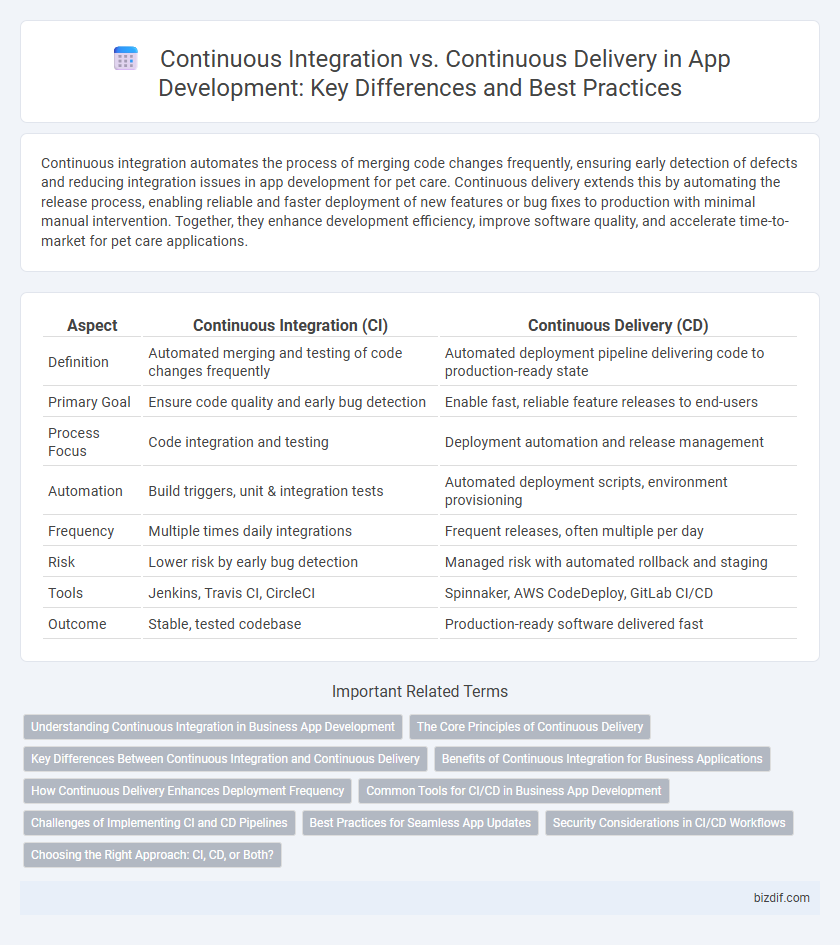Continuous integration automates the process of merging code changes frequently, ensuring early detection of defects and reducing integration issues in app development for pet care. Continuous delivery extends this by automating the release process, enabling reliable and faster deployment of new features or bug fixes to production with minimal manual intervention. Together, they enhance development efficiency, improve software quality, and accelerate time-to-market for pet care applications.
Table of Comparison
| Aspect | Continuous Integration (CI) | Continuous Delivery (CD) |
|---|---|---|
| Definition | Automated merging and testing of code changes frequently | Automated deployment pipeline delivering code to production-ready state |
| Primary Goal | Ensure code quality and early bug detection | Enable fast, reliable feature releases to end-users |
| Process Focus | Code integration and testing | Deployment automation and release management |
| Automation | Build triggers, unit & integration tests | Automated deployment scripts, environment provisioning |
| Frequency | Multiple times daily integrations | Frequent releases, often multiple per day |
| Risk | Lower risk by early bug detection | Managed risk with automated rollback and staging |
| Tools | Jenkins, Travis CI, CircleCI | Spinnaker, AWS CodeDeploy, GitLab CI/CD |
| Outcome | Stable, tested codebase | Production-ready software delivered fast |
Understanding Continuous Integration in Business App Development
Continuous Integration (CI) in business app development involves automatically merging code changes into a shared repository multiple times a day, enabling early detection of defects and reducing integration issues. CI tools such as Jenkins, CircleCI, and GitLab CI streamline the build, test, and deployment processes, ensuring consistent and reliable code quality. By integrating automated testing and real-time feedback, CI accelerates development cycles, enhances collaboration among developers, and supports frequent, incremental updates to business applications.
The Core Principles of Continuous Delivery
Continuous delivery emphasizes automating the release process, ensuring software can be reliably and rapidly deployed to any environment. Key principles include maintaining a deployable state at all times, using version control for all production artifacts, and implementing automated testing to validate changes continuously. This approach minimizes risks, accelerates feedback loops, and enhances collaboration across development, QA, and operations teams.
Key Differences Between Continuous Integration and Continuous Delivery
Continuous integration (CI) automates the process of merging code changes into a shared repository multiple times a day, emphasizing automated testing and build verification to identify issues early. Continuous delivery (CD) builds on CI by automating the deployment process, ensuring that code changes can be reliably released to production or staging environments at any time. The key difference lies in CI focusing on code integration and immediate validation, while CD extends this process to include automated release readiness and deployment automation.
Benefits of Continuous Integration for Business Applications
Continuous Integration (CI) significantly enhances business applications by enabling faster detection and resolution of code defects, which reduces deployment risks and improves software quality. Automated testing and integration streamline the development process, accelerating release cycles and increasing team productivity. This continuous feedback loop ensures that business applications remain stable, scalable, and aligned with evolving user requirements.
How Continuous Delivery Enhances Deployment Frequency
Continuous Delivery automates the release process, enabling development teams to deploy code changes more frequently and reliably to production environments. By maintaining a production-ready codebase and utilizing automated testing, it reduces the risk of deployment failures and accelerates the feedback loop. This increased deployment frequency improves time-to-market and allows faster delivery of new features and bug fixes to end-users.
Common Tools for CI/CD in Business App Development
Jenkins, GitLab CI, and CircleCI dominate as common tools for Continuous Integration in business app development, enabling automated code testing and integration. For Continuous Delivery, tools like Spinnaker, Octopus Deploy, and AWS CodeDeploy streamline the release process by automating application deployments to production environments. Combining these CI/CD tools accelerates development cycles, reduces errors, and enhances software quality in enterprise applications.
Challenges of Implementing CI and CD Pipelines
Implementing Continuous Integration (CI) and Continuous Delivery (CD) pipelines presents challenges such as complex toolchain integration, requiring seamless coordination between version control systems, build servers, and deployment platforms. Ensuring consistent automated testing across diverse environments often demands substantial effort to maintain test accuracy and reliability. Pipeline security and scalability issues further complicate implementation, necessitating robust access controls and infrastructure capable of handling growing workflows efficiently.
Best Practices for Seamless App Updates
Implementing automated testing within continuous integration (CI) pipelines ensures that code changes are validated quickly, reducing errors during integration. Continuous delivery (CD) best practices involve deploying code to staging environments for rigorous testing and automated approval processes before production release. Leveraging CI/CD tools like Jenkins, GitLab CI, or CircleCI streamlines app updates, enabling rapid, reliable, and seamless delivery to end-users.
Security Considerations in CI/CD Workflows
Continuous integration (CI) and continuous delivery (CD) workflows require rigorous security measures to prevent vulnerabilities during code integration and deployment stages. Implementing automated security testing, including static application security testing (SAST) and dynamic application security testing (DAST), helps identify threats early in the CI/CD pipeline. Secure secrets management and role-based access controls are critical to maintaining integrity and preventing unauthorized access throughout the development lifecycle.
Choosing the Right Approach: CI, CD, or Both?
Choosing the right approach between continuous integration (CI) and continuous delivery (CD) depends on the development team's goals and deployment frequency. CI emphasizes automated testing and code integration to detect issues early, while CD extends this by automating release processes for faster and more reliable software delivery. Many modern app development workflows benefit from combining CI and CD to streamline build, test, and deployment cycles effectively.
Continuous integration vs Continuous delivery Infographic

 bizdif.com
bizdif.com